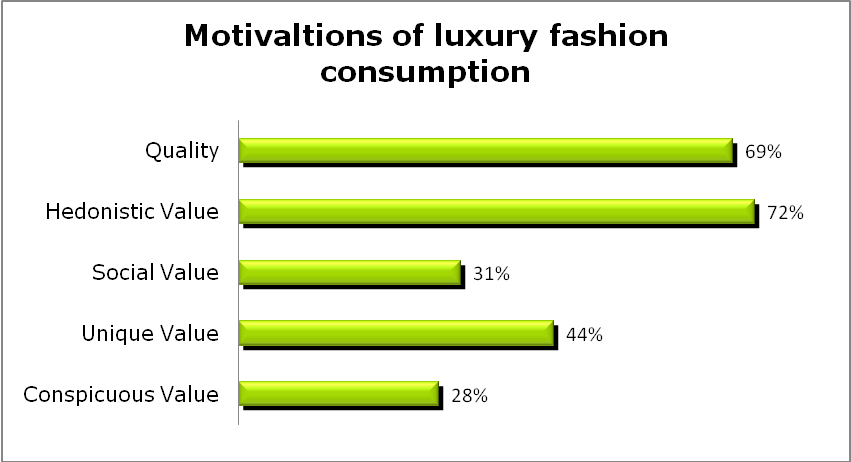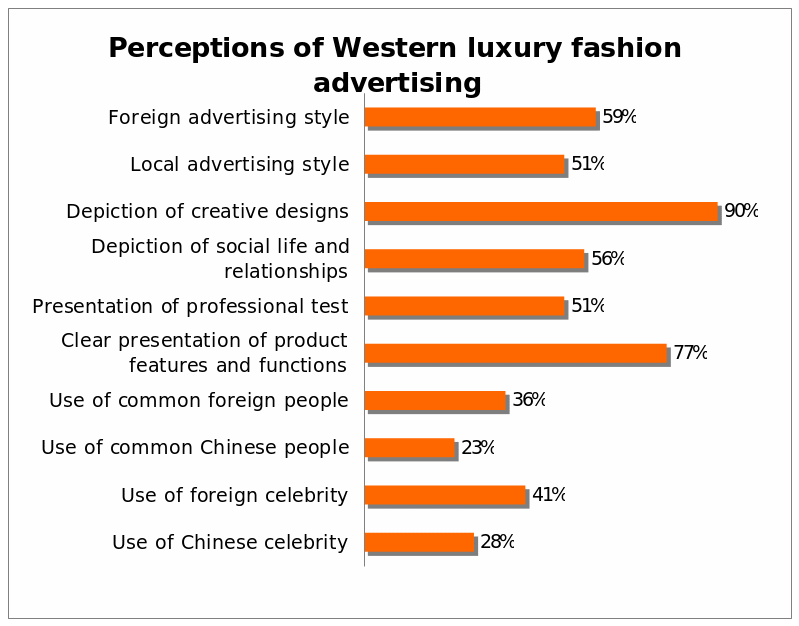Introduction
Analysis of the customer business sphere of any particular geographic region is closely associated with the sociological research and the analysis of the gained results. The aim of this paper is to systematize the gained results, as well as provide thee analysis of the collected data in the context of customer buying behavior for the further definition of customer aspect of Chinese geographic and business regions. In accordance with the research methodology, the data, gained on the basis of the questionnaires was collected and represented in the particular graphs, which will be used for the outlining of the findings, and defining the main features of a “Chinese Customer”.
Personal values
The first, graph, which requires analysis, is the graph, which summarizes the issues of personal values. The fact is that, these issues are regarded to be the basic for defining the consumer behavior of any market. Consequently, in order to create an advertising strategy, there is strong necessity to possess at least basic data about the target audience.
Thus, as the graph shows, the most important personal value for Chinese customers are the issues of enjoyment and fun, consequently, there is strong potential for the development of entertainment industry. Self-fulfillment, which is originally close to entertainment, is the second factor, which defines the image of a customer.

All the other factors are less important, nevertheless, they require to be taken into consideration as few are lower than 60%, which is considered to be the high numbers. As for the matters of personal values in general, Shen (2007, p. 401) emphasized the following statement in his research:
Marketers have long recognized the importance of attitudes in consumer behavior but the role of values has received relatively little attention, toward innovations especially. Values resemble attitudes in that both are adaptation abstractions that emerge continuously from the assimilation, accommodation, organization and integration of environmental information, in order to promote interchanges with the environment favorable to the preservation of an optimum function.
In the light of this perspective, it should be emphasized that Chinese consumers may be regarded as the potential target audience for numerous business spheres, especially taking into considerations the fact, that most of the provided values are too important for the consumers.
Another issue, which is important is the feeling of self respect (84%), feeling of being respected by others (73%), and warm relations with the surrounding people (76%). Originally, these values are the universal among the people of all over the world, and Chinese consumers do not differ from the others.
The values can be regarded as the defining factor for the elements and messages which may orient the luxury fashion advertisement campaigns, with the emphasis on “post-1980s” Chinese consumer.
Motivations of Luxury Fashion Consumption
This question is designed to examine consumers’ motivation behind luxury fashion consumption. Taking into consideration the fact that leisure and entertainment is the most important personal value for the consumers of this geographic region, it should be emphasized that the fashion market, which is poorly developed in China, may be developed extensively. In order to clarify this issue, another graph was developed.

Originally, it represents the main values, which consumers appreciate in the fashionable clothes, and the reasons, why they buy them. The fact is that, this factor is reasonable only for trendy fashion clothes. From this perspective, it should be highlighted that the regarded factors reflect interpersonal effects, while the last two reflect personal effects on prestige consumption. The Hedonistic value (72%) appears to be the most important, thus, it should be emphasized that the consumers will be oriented at the hedonistic features of the clothes. Another feature is quality, nevertheless, this variant of the replies may be distorted, as often it is hard to estimate the quality of a production at first sight. Social value, and the uniqueness of the clothes are the least important features, nevertheless, socialization is one of the most important factor for the Chinese customer (Kunkel and Wellin, 2006)
Vigneron and Johnson (1999) also point out that the strategy for promoting fashionable clothes may be elaborated basing on the matters of the discovered facts, and considering the notions of motivation, represented in the findings.
The consumers’ behavior, which should be analyzed taking into consideration the motivation issues, is generally regarded to be based on the principles of personal values, which are discussed in the previous part of the work. In accordance with the researches, dedicated to the matters of luxury consumption, Asian countries appear to be the most conservative and ascetic, nevertheless, the Chinese consumers are the leaders of luxury consumption. (Yangwen, 2007)
Perception of Western Luxury Fashion Advertising
The attitude of the consumers towards western luxury clothes is the matter, which the western cloth manufacturers are concerned with. The fact is that, the traditional Asian market may be regarded as rather conservative, nevertheless, the research revealed that the Chinese consumers are loyal enough towards the western clothing production.

Originally, this section is aimed at investigating consumer attitudes towards Western luxury fashion advertising and to identify the most effective messages for Western luxury fashion advertising among the “post-1980s” consumers in China. As indicated in the introduction, luxury fashion advertisements, which are effective in Western countries, might not work in China. From this perspective, it should be stated that the traditional post 80th China may be responsive for numerous strategies, nevertheless, there is strong necessity to define which means and strategies will be more effective, and what values of the luxury western clothes the Chinese consumers appreciate the most.
As for the matters of motivation, there is strong necessity to emphasize the notion by Durning (2004, p.116). They claim that the original issues in the matters of perception are dictated by the factor of social values and originality of the design. The research has only confirmed this, as the creative design is the most important factor (90%)
Approach to Advertising Process
The factors, described in question 18 are the approaches towards creation the advertising campaign. On the one hand, the Chinese customers feel themselves unique audience, nevertheless, the survey showed that this is the most entangling issue. Thus, 46% of the respondents agreed that global fashion brand, when advertised in China, should maintain the same design for its advertisements as in its country of origin, nevertheless 67% agreed that when foreign fashion brand enters China, its advertising strategy should be adapted for better perception of Chinese consumers. Marketologists will be rather confused, consequently, additional survey should be held, where these issues should be clarified.
Conclusion
The key notion, which should be derived from the represented data is that the Chinese consumers are sufficiently open for the extended advertising campaign. The research, and the methodology, which was applied towards the research discovers the consideration, pointing put the values and preferences of the Chinese consumers’ business sector. From the perspective of the provided data and discovered facts there is strong necessity to mention that the luxury advertising and luxury consumption is not extensively developed, nevertheless, the motivational factors are strong enough to stimulate the sector of luxury goods and luxury clothes in general.
As for the matters of consuming behavior in general, it should be emphasized that the original values, which are pursued by the consumers are defined with the help of the questionnaire, and are represented on the graph in the corresponding chapter of the paper.
All the data was gathered with the assistance of the focus groups, who provided information regarding the primary intentions behind luxury fashion purchases and the involvement of effective marketing channels for the Western luxury fashion brands among the “post-1980s” consumers in China. The interview data was analyzed by thematic content, with great care taken to avoid as much as possible the researcher’s subjective bias in the qualitative study. In the light of this fact, it should be emphasized that the original values of Chinese consumers are close to the values of most Asian immigrants in the USA. Taking into consideration that the Chinese market of luxury goods is one of the most liberal, it should be stated that there is a great potential for the western manufacturers. Consequently, the following step of the research will be associated with the matters consuming behavior, and values, which will be appreciated in the commercial videos and photos.
The key premise, which should be taken into consideration is closely associated with the fact, that Chinese people, shy by nature, will not confess openly that fun, leisure and entertainment are the key values for them. Nevertheless, they are open enough to share their preferences in accordance to the values, which they appreciate most in the goods and productions they purchase.
References
Bagozzi, R. P., Gürhan-Canli, Z., & Priester, J. R. (2002). The Social Psychology of Consumer Behaviour. Philadelphia: Open University Press.
Durning, A. T. (2004). How Much Is Enough? The Consumer Society and the Future of the Earth. New York: Norton.
Fan, J. X., & Xiao, J. J. (2005). Consumer Decision-Making Styles of Young-Adult Chinese. Journal of Consumer Affairs, 32(2), 275
Kahle, Lynn R., Beatty, Sharon E. and Homer, Pamela (2008). Alternative Measurement Approaches to Consumer Values: The List of Values (LOV) and values and life styles (VALS). Journal of Consumer Research, Gainesville: Dec. 13(3): 405-409.
Kunkel, S. R. & Wellin, V. (Eds.). (2006). Consumer Voice and Choice in Long-Term Care. New York: Springer.
Pan, Y., & Schmitt, B. (2001). Language and Brand Attitudes: Impact of Script and Sound Matching in Chinese and English. Journal of Consumer Psychology, 5(3), 263-277.
Shen, D. (2007). Sherman Cochran. Chinese Medicine Men: Consumer Culture in China and Southeast Asia. China Review International, 14(2), 401
Spahn, E. (2006). As Soft as Tofu: Consumer Product Defamation on the Chinese Internet. Vanderbilt Journal of Transnational Law, 39(3), 865
Vigneron, Franck and Johnson, Lester W. (2003) A Review and a Conceptual Framework of Prestige-Seeking Consumer behavior. Academy of Marketing Science Review, Vol 1999 No.1. Web.
Yangwen, Z. (2007). Chinese Medicine Men: Consumer Culture in China and Southeast Asia. Journal of Southeast Asian Studies, 38(1), 165.